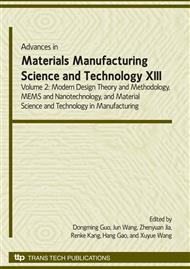p.103
p.109
p.113
p.119
p.125
p.131
p.137
p.143
p.149
The Reconfigurable Innovation of Reciprocating Rectilinear Moving Mechanism at High Frequency with Low Load Driven by Two Symmetrical Eccentric Cams
Abstract:
In many occasions of the practical engineering, the reciprocating rectilinear movement at high frequency is appeared commonly, which is usually completed by the slider-crank mechanism. But there has big friction force between the guide rail and the block, thus the big friction loss can be caused. So when working in a long time, the mechanism will be heated and distorted. And a big torque will be caused in the guide rail, the oscillation will be generated when move at high frequency. In order to overcome these defections, the reciprocating rectilinear moving mechanism at high frequency with low load driven by two symmetrical eccentric cams is innovated. And to realize the different travel in economical way, the rapid reconfigurable devices based on this mechanisum are innovated too. These innovated mechanism is quite symmetrical, so the friction force between the guide rail and the leader can be almost ignored and the oscillation is very small too. Then, the mechanical and movement property are analyzed and compared with the slider-crank mechanism, which proves that these mechanism have simple structure and good property. Through the analysis of the travel, the merit of strong adaptability is found out. Furthermore, the components in these devices can be reused in different occasions, so the reconfigurable thinking provides one economical method for big production rapidly.
Info:
Periodical:
Pages:
125-130
Citation:
Online since:
August 2009
Authors:
Price:
Сopyright:
© 2009 Trans Tech Publications Ltd. All Rights Reserved
Share:
Citation:


